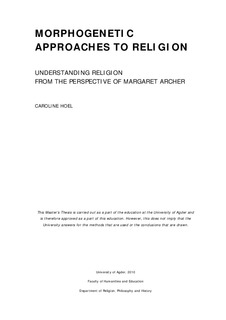| dc.contributor.author | Hoel, Caroline | |
| dc.date.accessioned | 2010-09-22T13:10:50Z | |
| dc.date.available | 2010-09-22T13:10:50Z | |
| dc.date.issued | 2010 | |
| dc.identifier.uri | http://hdl.handle.net/11250/139559 | |
| dc.description | Masteroppgave i religion- Universitetet i Agder 2010 | en_US |
| dc.description.abstract | The general theory and methodology offered by Margaret Archer under the name of “the morphogenetic approach” represents the major developments within critical realist social theory. Archer combines the critical realist ontology of stratified reality and complex causality with emergence- and interest theory in an innovative framework for social-scientific analysis. By taking this framework to the sociology of religion this thesis sheds light on familiar topics from a novel angle. The morphogenetic approach has as its key feature an analytically dualistic view of structure and agency. A stratified model of social agency highlights how the causal potential of humans must be understood in relation to in what respect they are acting: As individual, organised collectivity or within a role structure. Social structures are granted objective influence on interaction by shaping action contexts. By differentiating these levels in sociological explanation Archer maintains that the interplay of causal influences between structure and agency can be apprehended. Morphogenetic analyses trace historical trajectories of such interplays.
Religion becomes subject to different mechanisms and has different causal potentials depending on the aspect of analysis. In the morphogenetic perspective religion can be viewed as a system of meaning, as a repository of rational reasons to guide one’s action, as an ultimate concern which shapes our identity and perception of the world, as a powerful resource in collective struggles for upward mobility and as a force to be reckoned with in public social life and decision making. Religious interaction is guided by interests vested in the group’s position in the cultural and material domain. Religious change (morphogenesis) or stability (morphostasis) occurs as the result of the relative influence of religious agents within their cultural and structural action contexts.
This thesis finds that there may be significant advantages for the sociology of religion by taking a morphogenetic approach in practical study. The advantages are primary related to instances of change, and particularly at the levels of group interaction. Archer also offers an exciting, if controversial, view on the importance of religious belief and experience in identity formation that could be an interesting point of departure for future research. | en_US |
| dc.language.iso | eng | en_US |
| dc.publisher | Universitetet i Agder, University of Agder | en_US |
| dc.subject.classification | REL 500 | |
| dc.title | Morphogenetic approaches to religion : understanding religion from the perspective of Margaret Archer | en_US |
| dc.type | Master thesis | en_US |
| dc.subject.nsi | VDP::Humanities: 000::Theology and religious science: 150::Religious science, religious history: 153 | en_US |
| dc.source.pagenumber | 148 s. | en_US |
